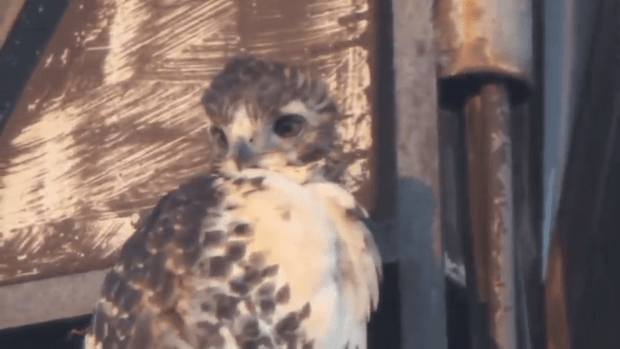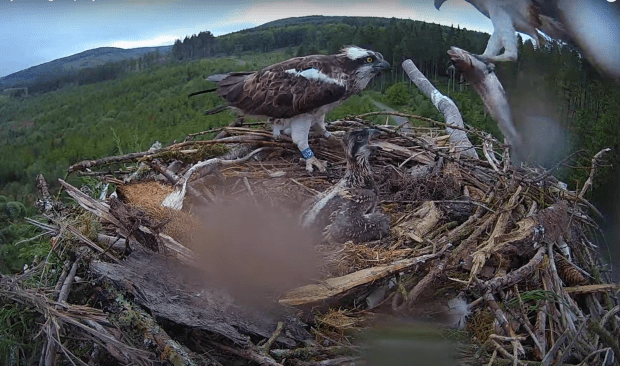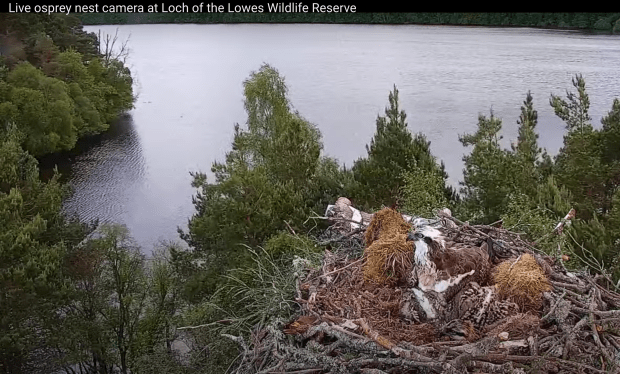Juvenile Osprey Blue 096 has fledged from the Rutland Manton Bay Nest of Maya and Blue 33 (11). It happened at 12:12:27 pm.
He looks up.

Wings begin flapping. Blue 095 goes, “oh, not this again! This nest is getting too small for flapping. I wish you would just go away!”

He’s on tippy toes and grabs the wind and…

Blue 096, male chick of Maya and Blue 33 (11) fledges on 1 July 2021.

Jack delivers a breakfish to Tiny Tot this morning. Oh, thank goodness! It is 28 degrees C and the weather service says there is a 40% of a thunderstorm around 5pm in St Petersburg, Florida. Thanks, Jack!
By 9:29 Tiny Tot will have that fish out of dad’s talons and she will be saying ‘Yum’.

There were, to my knowledge no fish deliveries to Tiny last evening. She was really waiting and watching for dad. Turns out it is a small headless fish, a bit of a teaser for our gal who chowed down on that whopper the other day, this morning.
Look at those magnificent wings. Tiny, you are such a gorgeous bird!


Well, one of those nests that I suggested you watch when others get stressful just turned up the noise. Lady Hawk posted a video of the Royal Cam chick going to visit her neighbor SSTrig and the neighbour gets into a big territorial dispute. Taiki is very social and meant no harm but we now know there won’t be any afternoon tea parties with these two. Here is that video:
There is great news coming out of New Zealand. Remember I love this country for the way in which it takes care of its wildlife. Well, today, New Zealand announced that it is putting surveillance cameras on all of its fishing boats to make sure that they comply with safe fishing so that no seabirds are caught as bycatch. Way to go New Zealand!
The landscape at the Glaslyn Nest of Mrs G and Aran in Wales is stunningly beautiful. I admit to dreaming of trees and places where you can look out and see birds and not the concrete of the city. Of sitting and smelling the wet grass and hay and not the petrol fumes of cars. Of disappearing into the wilderness.

Aran and Mrs G are spending more and more time together. Aran is able to fish after his injury in early June but he is still healing. There will be no more chicks this year but the couple was seen bonding. That is fantastic!

Aran brought in a big fish earlier that he was eating. I wonder if he shared it with Mrs G who now has a nice chunk and the tail in her talons. He has provided at least one fish to her that was caught on camera which is a great indication of Aran’s continuing progress in healing.

The two Bobs at the Dyfi Osprey Nest in Wales are enjoying a lovely fish that Idris delivered. Telyn is a fantastic mom but that nest is getting a little crowded. She may have to stand on the rails to feed her babies soon. These two are growing like crazy! You might remember that Dysynni, the male, is the largest male Osprey born on this nest ever. Idris has really brought in some of the large fish. It has been determined that many of those fish actually weigh more than Idris – breaking another myth that Ospreys can only carry a % of their actual weight.
It also demonstrates how much food and the quantity of it matter to the health and well being of the chicks. This is the nest of a super dad – as are many of those in Wales and other parts of the UK.

Meanwhile, over in Scotland, the two Bobs on the Loch of the Lowes nest are waiting for NC0 or Laddie to bring them in a tea time fish. Gosh these Bobs are beautiful. The time has flown by and they will soon be hovering and fledging but, in those very first days, I really wondered if Bob 2 would survive the bonking from Bob 1.

And goodness, I woke up this morning and had to look twice to figure out which of the chicks on the Foulshaw Moss Nest of White YW and Blue 35 was Tiny Little Bob! Which one do you think is Tiny Little?

If you said the one closest to the right looking out, you would be right. She or he is watching for one of the parents to arrive with a fish! As noted from the people who ringed the chicks, they could not determine the gender of Tiny Little from the measurements because of its small size at the time. Rumours had gone around that Tiny Little is, in fact, a female.
Today, the Cumbrian Wildlife Trust put out their announcement about the ringing of these three Ospreys. Part of the celebration is that Tiny Little was the 100th osprey chick to be banded in Cumbria since 2001. That is amazing. Here is part of the text that was posted:
“I’m incredibly pleased that we have ringed another three osprey chicks at Foulshaw Moss Nature Reserve this year. For a time we we’re unsure if the smallest chick was going to make it. It was rapidly being outgrown by its bigger siblings but it carried on fighting for its share of the food from mum and dad. Now there’s not much difference in weight – and it was the smallest one that was the 100th osprey chick to be ringed in Cumbria since 2001! Osprey chicks are weighed by the licenced bird ringer and each chick is given a coloured leg ring. This year we have Blue 462, a female weighing 1.6kg, Blue 463 weighing 1.5kg – gender unknown, and Blue 464, a male weighing 1.6kg”.
Paul Waterhouse, Cumbria Wildlife Trust
I wanted to check in on the little Golden Eaglet in Bucovina, Romania. He has changed so much in just a few days. Most of the white feathers are gone and are now replaced with the beautiful dark black kind of espresso coloured ones for the juveniles.

The female has come to the nest to feed the eaglet. There were lots of bones and scraps of meat left on them. It is unclear to me whether or not the mother has brought in new prey or is using what is in the pantry.
You can look and see the remote mountain area where this nest is located. I continue to hope that the parents are able to find enough prey for this little one to thrive and fledge.

Thank you so much for joining me today. I regret I have no images of the Ks for you – maybe later today. They are off exploring the trees and some of the buildings with Big Red and Arthur. Everyone is fine; they are just not around the nest!
Thank you to the following for their streaming cams where I obtained my screen shots: Bywyd Gwyllt Glaslyn, Cumbria Wildlife Trust and Foulshaw Moss Osprey Nest, Scottish Wildlife Trust and Friends of Loch of the Lowes, Achieva Credit Union, Asociatia Wild Bucovina, LRWT and Manton Bay Osprey Nest, Cornell Bird Cam Royal Albatross and NZ DOC, and Dyfi Osprey Projec. I would also like to thank Lady Hawk for her video clip of the territorial dispute between Taiki and SSTrig.










































































